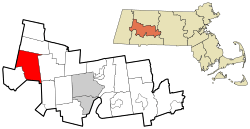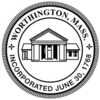Worthington, Massachusetts facts for kids
Quick facts for kids
Worthington, Massachusetts
|
|||
|---|---|---|---|

Corners Grocery
|
|||
|
|||

Location in Hampshire County in Massachusetts
|
|||
| Country | United States | ||
| State | Massachusetts | ||
| County | Hampshire | ||
| Settled | 1764 | ||
| Incorporated | 1768 | ||
| Government | |||
| • Type | Open town meeting | ||
| Area | |||
| • Total | 32.1 sq mi (83.1 km2) | ||
| • Land | 31.9 sq mi (82.7 km2) | ||
| • Water | 0.2 sq mi (0.4 km2) | ||
| Elevation | 1,433 ft (437 m) | ||
| Population
(2020)
|
|||
| • Total | 1,193 | ||
| • Density | 37.18/sq mi (14.356/km2) | ||
| Time zone | UTC-5 (Eastern) | ||
| • Summer (DST) | UTC-4 (Eastern) | ||
| ZIP Code |
01098
|
||
| Area code(s) | 413 | ||
| FIPS code | 25-82175 | ||
| GNIS feature ID | 0618212 | ||
Worthington is a small town in Hampshire County, Massachusetts, United States. In 2020, about 1,193 people lived there. This was a small increase from 1,156 people in 2010. Worthington is part of the larger Springfield area.
You might have heard of Worthington in songs! The musician Aaron Lewis mentions Worthington in his song "Massachusetts." He also refers to its small population in his song "Country Boy." Both songs are from his 2011 album, Town Line.
Contents
History of Worthington
How Worthington Began
Worthington was first settled in 1764. It officially became a town in 1768. Before this, the area was mostly wild land. People from Northampton had looked for new land to settle.
Changes Through the Years
In the 1840s and 1850s, trains became a new way to travel. People tried to get a train line built through Worthington, but it didn't happen. Even though a train station was built nearby in Huntington, many families in Worthington started to sell their farms. They moved west to places like New York and Ohio, looking for cheaper land. By the 1860s, Worthington's population had dropped to 925 people.
The town's population kept getting smaller for many years. It went down to 569 people by 1910. But even with fewer people, many important town places were built. For example, the second Congregational Church burned down in 1887. A new church, with a steeple, bells, and stained glass windows, was built in its place and opened in 1888.
A Summer Getaway
Even as the number of farmers living in Worthington decreased, the town became known as a summer vacation spot. A casino, a hotel, and many summer homes brought visitors and money to the town. Making maple syrup also became a bigger business during this time.
The population dropped even more during the 1930s and 1940s, reaching its lowest point of 363 people in 1945. Because there were fewer people, Worthington's small, one-room schools closed. Post offices were combined, and a local community group called The Grange had to join with groups from other towns. A famous inn, the Lafayette Inn, burned down in 1931 and was never rebuilt.
Growing Again
In the 1950s and 1960s, Worthington started to grow again. This was partly because roads got better, making it easier to travel. In 1949, the town decided to build a new fire station, which was finished the next year. A club for artists, called the Palettes and Trowels Club, started in 1950. It became a place for many artists in Worthington.
In 1968, Worthington celebrated its 200th birthday! There was a parade, an antique fair, a photo exhibit, and tours of homes. There was even a play and a beard-growing contest. The town continued to grow in the late 1960s and early 1970s. In the 1980s, the Hilltown Artisans Guild was created to support local artists.
Geography of Worthington
Worthington is located in the western part of Hampshire County. It is right next to an area called the Berkshires. The town shares borders with several other towns. These include Cummington to the north and Chesterfield to the east.
Inside Worthington, there are a few smaller villages. Worthington Center and Worthington Corners are close to the middle of the town. Ringville and South Worthington are in the southeast, and West Worthington is in the northwest.
Roads and Rivers
Massachusetts Route 112 goes through Worthington. It heads north to Cummington and south to Huntington. Another road, Massachusetts Route 143, briefly follows Route 112. But then it goes east to Chesterfield and Williamsburg, and west to Peru and Hinsdale.
Worthington covers about 83.1 square kilometers (about 32.1 square miles). Most of this area is land, with only a small part being water. The town is part of the Westfield River area. The Middle Branch of the Westfield River flows through the western side of Worthington.
Climate in Worthington
Worthington has a climate with warm summers and cold, snowy winters.
| Climate data for Worthington, Massachusetts, 1991–2020 normals: 1285ft (392m) | |||||||||||||
|---|---|---|---|---|---|---|---|---|---|---|---|---|---|
| Month | Jan | Feb | Mar | Apr | May | Jun | Jul | Aug | Sep | Oct | Nov | Dec | Year |
| Record high °F (°C) | 65 (18) |
73 (23) |
81 (27) |
89 (32) |
91 (33) |
93 (34) |
94 (34) |
93 (34) |
91 (33) |
84 (29) |
76 (24) |
69 (21) |
94 (34) |
| Mean maximum °F (°C) | 53.5 (11.9) |
55.1 (12.8) |
63.9 (17.7) |
78.2 (25.7) |
84.8 (29.3) |
87.8 (31.0) |
88.9 (31.6) |
87.6 (30.9) |
84.9 (29.4) |
76.2 (24.6) |
66.6 (19.2) |
56.5 (13.6) |
90.3 (32.4) |
| Mean daily maximum °F (°C) | 31.5 (−0.3) |
34.6 (1.4) |
42.5 (5.8) |
55.4 (13.0) |
66.7 (19.3) |
74.7 (23.7) |
79.6 (26.4) |
78.1 (25.6) |
71.4 (21.9) |
59.1 (15.1) |
47.0 (8.3) |
36.4 (2.4) |
56.4 (13.6) |
| Daily mean °F (°C) | 21.7 (−5.7) |
23.6 (−4.7) |
31.6 (−0.2) |
43.5 (6.4) |
54.6 (12.6) |
63.1 (17.3) |
67.9 (19.9) |
66.3 (19.1) |
59.2 (15.1) |
47.6 (8.7) |
37.1 (2.8) |
27.6 (−2.4) |
45.3 (7.4) |
| Mean daily minimum °F (°C) | 11.9 (−11.2) |
12.7 (−10.7) |
20.6 (−6.3) |
31.6 (−0.2) |
42.5 (5.8) |
51.5 (10.8) |
56.3 (13.5) |
54.5 (12.5) |
47.0 (8.3) |
36.2 (2.3) |
27.2 (−2.7) |
18.8 (−7.3) |
34.2 (1.2) |
| Mean minimum °F (°C) | −7.6 (−22.0) |
−5.2 (−20.7) |
2.0 (−16.7) |
20.2 (−6.6) |
28.8 (−1.8) |
37.7 (3.2) |
46.6 (8.1) |
43.7 (6.5) |
33.3 (0.7) |
23.3 (−4.8) |
12.0 (−11.1) |
2.7 (−16.3) |
−9.1 (−22.8) |
| Record low °F (°C) | −16 (−27) |
−19 (−28) |
−13 (−25) |
8 (−13) |
22 (−6) |
32 (0) |
41 (5) |
38 (3) |
25 (−4) |
16 (−9) |
−4 (−20) |
−9 (−23) |
−19 (−28) |
| Average precipitation inches (mm) | 3.95 (100) |
3.56 (90) |
4.25 (108) |
4.29 (109) |
4.20 (107) |
5.12 (130) |
4.57 (116) |
4.46 (113) |
4.78 (121) |
5.59 (142) |
4.10 (104) |
5.22 (133) |
54.09 (1,373) |
| Average snowfall inches (cm) | 19.30 (49.0) |
18.20 (46.2) |
13.80 (35.1) |
4.00 (10.2) |
0.10 (0.25) |
0.00 (0.00) |
0.00 (0.00) |
0.00 (0.00) |
0.00 (0.00) |
0.40 (1.0) |
4.60 (11.7) |
16.70 (42.4) |
77.1 (195.85) |
| Source 1: NOAA | |||||||||||||
| Source 2: XMACIS (temp records & monthly max/mins) | |||||||||||||
People in Worthington
| Historical population | ||
|---|---|---|
| Year | Pop. | ±% |
| 1850 | 1,134 | — |
| 1860 | 1,041 | −8.2% |
| 1870 | 860 | −17.4% |
| 1880 | 758 | −11.9% |
| 1890 | 714 | −5.8% |
| 1900 | 675 | −5.5% |
| 1910 | 569 | −15.7% |
| 1920 | 409 | −28.1% |
| 1930 | 486 | +18.8% |
| 1940 | 471 | −3.1% |
| 1950 | 462 | −1.9% |
| 1960 | 597 | +29.2% |
| 1970 | 712 | +19.3% |
| 1980 | 932 | +30.9% |
| 1990 | 1,156 | +24.0% |
| 2000 | 1,270 | +9.9% |
| 2010 | 1,156 | −9.0% |
| 2020 | 1,193 | +3.2% |
| 2022* | 1,183 | −0.8% |
| * = population estimate. Source: United States Census records and Population Estimates Program data. |
||
In 2000, there were 1,270 people living in Worthington. There were 503 households, and 363 of these were families. About 31.8% of households had children under 18. Most households (60.8%) were married couples.
The average age of people in Worthington was 42 years old. About 24.5% of the population was under 18. About 11.0% were 65 years or older.
Maple Syrup and Sugar Houses
Worthington is known for its farms. One important farm product is maple syrup! The town has three "sugar houses" that are open almost all year. This is where maple syrup is made from maple tree sap.
Famous People from Worthington
- Russell Conwell (1843–1925) - He started Temple University.
- Aaron Lewis - He is the lead singer of the band Staind and also a country music singer. He lives in Worthington.
- Alfred P. Stone (1813–1865) - He was a US congressman from Ohio.
Images for kids
See also
 In Spanish: Worthington (Massachusetts) para niños
In Spanish: Worthington (Massachusetts) para niños





